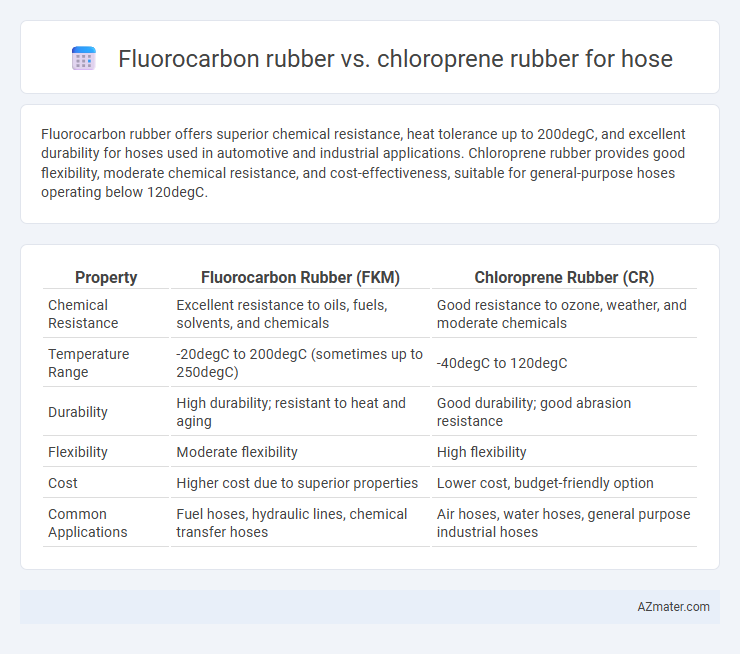Fluorocarbon rubber offers superior chemical resistance, heat tolerance up to 200degC, and excellent durability for hoses used in automotive and industrial applications. Chloroprene rubber provides good flexibility, moderate chemical resistance, and cost-effectiveness, suitable for general-purpose hoses operating below 120degC.
Table of Comparison
| Property | Fluorocarbon Rubber (FKM) | Chloroprene Rubber (CR) |
|---|---|---|
| Chemical Resistance | Excellent resistance to oils, fuels, solvents, and chemicals | Good resistance to ozone, weather, and moderate chemicals |
| Temperature Range | -20degC to 200degC (sometimes up to 250degC) | -40degC to 120degC |
| Durability | High durability; resistant to heat and aging | Good durability; good abrasion resistance |
| Flexibility | Moderate flexibility | High flexibility |
| Cost | Higher cost due to superior properties | Lower cost, budget-friendly option |
| Common Applications | Fuel hoses, hydraulic lines, chemical transfer hoses | Air hoses, water hoses, general purpose industrial hoses |
Introduction to Fluorocarbon Rubber and Chloroprene Rubber
Fluorocarbon rubber (FKM) is a synthetic elastomer known for its exceptional resistance to high temperatures, chemicals, and oil, making it ideal for demanding hose applications in automotive and industrial environments. Chloroprene rubber (CR), commonly known as neoprene, offers good resistance to weathering, ozone, and moderate chemicals, providing versatility and durability for general-purpose hoses. Choosing between fluorocarbon and chloroprene rubber depends on the specific requirements for chemical exposure, temperature range, and environmental conditions in hose use.
Chemical Structure and Composition
Fluorocarbon rubber (FKM) features a backbone of carbon-fluorine bonds, providing exceptional resistance to chemicals, heat, and oils due to the strong electronegativity and stability of fluorine atoms. Chloroprene rubber (CR) consists of polychloroprene chains with chlorine atoms contributing to moderate chemical resistance, along with good ozone and weathering durability. The molecular composition of FKM enables superior performance in aggressive chemical environments, whereas CR offers balanced properties suitable for general-purpose hose applications.
Performance in High-Temperature Environments
Fluorocarbon rubber (FKM) exhibits superior resistance to high temperatures, maintaining flexibility and chemical integrity up to 250degC, making it ideal for hoses exposed to extreme heat and aggressive chemicals. Chloroprene rubber (CR) performs well in moderate heat environments, typically up to 120degC, but degrades faster under prolonged high-temperature exposure due to lower thermal stability. The enhanced thermal resistance and chemical durability of fluorocarbon rubber ensure longer hose life and reliable performance in demanding high-temperature applications compared to chloroprene rubber.
Resistance to Chemicals and Oils
Fluorocarbon rubber (FKM) exhibits superior resistance to a broad spectrum of chemicals and oils, maintaining its integrity in environments with exposure to aggressive fuels, lubricants, and solvents, making it ideal for high-performance hose applications. Chloroprene rubber (CR) offers moderate chemical resistance but tends to degrade when exposed to oils and certain hydrocarbons, limiting its use in applications requiring prolonged contact with such substances. For hoses requiring durability against harsh chemicals and oils, fluorocarbon rubber provides enhanced longevity and stability compared to chloroprene rubber.
Durability and Longevity in Hose Applications
Fluorocarbon rubber offers superior chemical resistance and high-temperature stability, making it highly durable for hose applications exposed to aggressive fluids and extreme conditions. Chloroprene rubber provides good abrasion resistance and moderate chemical resistance, suitable for general-purpose hoses but with shorter longevity under harsh environments. In terms of overall durability and longevity, fluorocarbon rubber hoses outperform chloroprene hoses, especially in demanding industrial applications requiring extended service life.
Flexibility and Mechanical Strength Comparison
Fluorocarbon rubber (FKM) offers superior mechanical strength, chemical resistance, and high-temperature durability, making it ideal for hoses exposed to aggressive fluids and extreme environments. Chloroprene rubber (CR) provides greater flexibility and good abrasion resistance, allowing for easier hose maneuverability and resilience under dynamic conditions. When selecting a hose material, fluorocarbon rubber excels in strength and chemical stability, whereas chloroprene rubber ensures better flexibility and elasticity for applications requiring frequent bending.
Cost Analysis: Fluorocarbon vs Chloroprene Rubber
Fluorocarbon rubber hoses typically exhibit higher initial costs compared to chloroprene rubber hoses due to advanced material properties like superior chemical and temperature resistance. Chloroprene rubber offers a more cost-effective solution with adequate durability for general-purpose applications, resulting in lower production and maintenance expenses. Evaluating the total cost of ownership should consider factors such as operational temperature ranges, chemical exposure, and hose lifespan to determine the best economic value between fluorocarbon and chloroprene hose options.
Typical Industrial Applications for Each Rubber Type
Fluorocarbon rubber hoses are typically used in chemical processing, automotive fuel systems, and aerospace industries due to their exceptional resistance to high temperatures, fuels, oils, and aggressive chemicals. Chloroprene rubber hoses excel in refrigeration, air conditioning, and petroleum-based fluid transfer applications because of their good balance of oil resistance, weatherability, and flexibility. Industrial sectors such as manufacturing and construction often select chloroprene for durability and resistance to harsh environmental conditions, while fluorocarbon is preferred in environments requiring superior chemical and heat resistance.
Environmental and Safety Considerations
Fluorocarbon rubber hoses exhibit superior chemical resistance and low permeability, making them ideal for handling aggressive fluids with reduced environmental contamination risks, while their thermal stability enhances operational safety in high-temperature applications. Chloroprene rubber hoses provide good resistance to oils and weathering but may release more hazardous degradation products under extreme conditions, raising environmental and health concerns. Selecting fluorocarbon rubber hoses supports stringent environmental regulations and workplace safety standards by minimizing toxic emissions and ensuring durable, reliable performance.
Choosing the Right Rubber for Your Hose Needs
Fluorocarbon rubber offers superior chemical resistance, high-temperature tolerance up to 204degC, and excellent durability for hoses exposed to aggressive fuels and oils, making it ideal for automotive and aerospace applications. Chloroprene rubber provides good resistance to ozone, weathering, and moderate chemical exposure with temperature limits around 120degC, suitable for general industrial hoses and outdoor use. Selecting the right rubber depends on the hose's operating environment, chemical exposure, and temperature requirements to ensure optimal performance and longevity.

Infographic: Fluorocarbon rubber vs Chloroprene rubber for Hose
 azmater.com
azmater.com